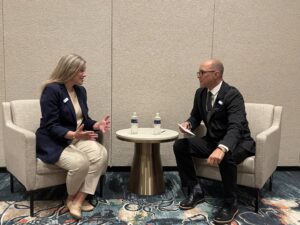The Elder Caregiving Crisis Facing American Workers
July 10, 2024
Introduction: Caregiving in the United States
As of 2020, approximately 53 million Americans provided care to an adult family member or friend. Of these caregivers, 61% also had jobs, according to the National Alliance for Caregiving and AARP study “Caregiving in the United States in 2020”, based on surveys carried out before the COVID-19 pandemic. These caregiving responsibilities include assisting with daily living activities, medical or nursing tasks, coordinating services and support, transportation, shopping, and advocating for their care recipient. According to AARP, most family caregivers provide at least 20 hours of care each week, equal to an unpaid part-time job.
To examine how the prevalence and state of caregiving have evolved since the last comprehensive survey in 2020, AARP and S&P Global conducted a new and updated survey in 2023. The survey identified 1,200 caregivers who work full-time or part-time at large US companies (with more than 1,000 employees) and provide at least six hours of care each week to an adult.
The updated survey revealed that the unpredictable nature of caregiving for an adult is among the biggest challenges that caregivers face. Additionally, the report revealed some concerning findings for workers balancing jobs and caregiving responsibilities:
67% of family caregivers said they have difficulty balancing their jobs with caregiving duties.
27% of working caregivers have shifted from full-time to part-time work or have reduced hours, and 16% have turned down a promotion.
16% have stopped working entirely for a period — and 13% have changed employers — to meet caregiving responsibilities.
So, caregiving impacts millions of US workers each year. The number of caregivers is growing as the population ages, and the impacts on workplaces in terms of absenteeism, lost productivity, reduced work availability, and even leaving work altogether seem likely to all increase in intensity and prevalence in the coming years. Someone turning 65 today has almost a 70% chance of needing long-term care services and support in their remaining years.
While solutions to the caregiving problem are complex, they help organizational leaders understand the problem before looking for solutions. Let’s examine the challenge in more detail, focusing on the types and access to caregiving facilities and resources, their affordability for workers, and what programs and tools are available to employers motivated to assist their employees with these challenges.
Types and Access Caregiving Resources
Caregiving facilities and senior living communities vary widely by type, cost, services, location, and amenities. Each caregiver must work with the person needing care to make the best decisions based on their health care needs. Active older adults with few health concerns often choose to age in place in their homes. Other healthy older adults may thrive in independent living communities, while those living with dementia or other chronic diseases may be better suited in communities providing attentive, daily care, such as assisted living, memory care, or nursing homes. Some of the most common caregiving facilities in the United States are described briefly below.
Independent Living
Independent living communities are typically condo-style buildings with amenities designed to serve older adults’ needs. They usually consist of one large building or several buildings on one campus, with a communal dining room, gathering areas for social activities, and a combination of studio, one-bedroom, and two- or three-bedroom apartments. Personal care services, such as help with activities of daily living (ADLs), are not provided by independent living communities, or medical services.
Low-income Senior Housing
Because many older adults live on fixed incomes, managing health care and other costs on top of paying rent or a mortgage can be challenging. Qualifying adults 62 and older can find subsidized senior apartments through the U.S. Department of Housing and Urban Development (HUD). HUD has programs that help older adults, people with disabilities, and low-income families find affordable housing. Low-income federal housing for older adults does not include housekeeping and personal care services. Residents in low-income housing who need medical care or personal care assistance may need to apply for Medicaid to receive more services.
Assisted Living
Assisted living communities provide many of the same services as independent living, such as social activities and communal meals. The primary difference between independent living and assisted living is the addition of personal care services, such as help with activities of daily living like bathing and dressing. Assisted living also offers medication administration and some medical services, though facilities do not require a registered nurse (RN) on staff.
Nursing Homes
A nursing home, sometimes called a skilled nursing facility or just skilled nursing, is a residence for adults needing ongoing, skilled care that can no longer be provided at home or in an assisted living community. Nursing homes offer both long-term residential care and short-term rehabilitative care. Many nursing homes also provide respite care, or temporary care for people living in other settings, to give their usual caregiver a break from caregiving responsibilities.
Memory Care
For older adults living with Alzheimer’s or another form of dementia, memory care offers a secure residential setting with locked entrances and exits to prevent residents from wandering. Some stand-alone memory care facilities exist, but many memory care communities are in assisted living or nursing home facilities. In this case, they are often referred to as special care units.
In-home Care
For adults choosing to age in place, receiving supportive services in the home is possible. In-home care, or home care, is often used as a catch-all term for a variety of services. The most common types of in-home care include:
Companion care or homemaker services: Provided by non-certified, non-licensed professionals, these services include companionship, running errands, and helping with household tasks like laundry and meal preparation.
Personal care services: Typically provided by non-licensed, non-certified professionals or certified nursing assistants (CNAs), personal care services include medication management, administration, and assistance with ADLs.
Remember that costs can vary significantly based on location, amenities, and level of care. It’s essential to research specific facilities and consider individual needs when making decisions: Provided by RNs and LPNs, home health care services include skilled nursing services, such as catheter care, wound care, and injections.
Affordability of Caregiving
When doing the research for this H3 HR Insights piece, I was taken aback by the high costs of caregiving and providing added services to older residents in the various types of care facilities. Suffice it to say, that the costs of providing long-term care for adults and seniors can be significant and present a major challenge for the persons needing care, and those charged with delivering or managing their care. Estimated monthly costs for the various caregiving services listed above are as follows. Note: The below cost data is taken from the US News and Report article “Long-Term Care Facilities: Types and Costs,” published in February 2024, and the National Council on Aging article “The Cost of Senior Living: Understanding and Comparing Your Options” published in October 2023.
Independent Living
Independent living communities’ monthly costs vary but range from $1,500 to $4,000.
Low-income Senior Housing
Older adults living in HUD housing pay 30% of their adjusted gross income. So, if you make $1,500 per month, your monthly rent would be $450.
Assisted Living
Assisted living communities generally cost between $4,000 to $6,000 per month.
Nursing Homes
A nursing home or skilled nursing facility can cost from approximately $7,500 to $9,000 monthly.
Memory Care
These more specialized facilities focusing on seniors with memory issues and concerns, can cost between $5,000 to $7,000 monthly.
In-home Care
The National Council on Aging reported a median monthly cost of $4,506 for 40 hours per week of homemaker services or companion care. The median monthly cost for 40 hours per week of home health aide services is $4,680. Of course, not everyone choosing in-home care will need 40 hours per week of support. Some older adults living at home may only need companion care for a few hours each week, while others require around-the-clock assistance.
Corporate Programs to Support Caregivers
Similar to how we examined the role employers can and should play in support of their employees facing challenges with childcare, employers can also enact policies, create a supportive culture, and offer more direct benefits aimed at helping workers with adult caregiving responsibilities. Many employers are increasingly recognizing the need to support employees who are caregivers. Here are some ways they are doing so, along with some examples of how a few large organizations have implemented specific benefit programs and policies that have been implemented:
- Flexible Work Arrangements
- Hybrid and Remote Work: Allowing employees to work from home can help caregivers manage their responsibilities more effectively.
- Flexible Hours: Offering flexible start and end times or compressed workweeks can provide caregivers with the time needed to handle caregiving duties.
- Paid and Unpaid Leave
- Family and Medical Leave Act (FMLA): This federal law allows eligible employees to take up to 12 weeks of unpaid leave for caregiving without losing their job.
- Paid Family Leave: Some states (e.g., California, New York, and New Jersey) offer paid family leave programs, and employers in these states provide benefits accordingly.
- Employer-Specific Paid Leave: Some companies offer additional paid leave for caregiving purposes beyond what FMLA requires.
- Employee Assistance Programs (EAPs)
- EAPs provide resources and support for caregivers, including counseling services, referral services, and stress management programs.
- Caregiver Support Programs
- Workplace Support and Employee Resource Groups: Employers may facilitate support groups where caregivers can share experiences and resources.
- Caregiving Resources: Providing access to caregiving workshops, informational webinars, and guides on managing caregiver responsibilities.
- Financial Support
- Caregiving Stipends: Some employers offer stipends to help cover the costs of caregiving.
- Dependent Care Flexible Spending Accounts (FSAs): These accounts allow employees to set aside pre-tax dollars for caregiving expenses.
- Partnerships with Caregiving Services
- Backup Care Services: Employers may partner with organizations that provide backup care services, ensuring that caregivers have access to professional care when needed.
- In-Home Care Services: Some employers offer access to discounted in-home care services through partnerships with caregiving organizations.
Examples of Employers Supporting Caregivers
While not all employers directly support employee’s caregiving needs, some notable organizations have implemented specific programs and benefits to help employees with these challenges. Some examples include:
- Johnson & Johnson
- It offers a comprehensive caregiving program that includes flexible work options, paid leave for caregiving, access to caregiving resources and support, and Global caregiver leave to support an immediate family member with a critical illness or injury.
- Microsoft
- Provides paid leave for caregivers, allowing an employee to take up to four weeks of fully paid leave to care for an immediate family member with a severe health condition. Additionally, they offer flexible work arrangements, and access to backup care services through partnerships with caregiving organizations.
- Bank of America
- It offers paid caregiver leave, flexible work schedules, and access to EAPs, including caregiving resources and counseling services. U.S. employees can access backup adult care when regular arrangements aren’t available.
Third-Party Employer Benefits Providers that Focus on Caregiving
Employers have an important role in creating a culture of support and safety for their employees with caregiving responsibilities – perhaps as many as a quarter of their workforce. For employers, partnering with third-party providers of caregiving resources and direct or indirect services is the most widely adopted approach to giving employees more access to care options, and in some cases, to make care more accessible and affordable.
Numerous caregiving services and resource providers work with employers wishing to include these essential benefits in their employee packages. Here’s a brief overview of the caregiving support services offered by some of the most well-known caregiving services and resource providers:
Family First
Services: Family First partners with employers to offer personalized caregiving solutions. Employees and their families gain access to a dedicated Care Team that addresses mental health, family dynamics, financial challenges, work-life balance, and more. Their Expert Caregiving Platform facilitates virtual care conferences, document storage, and real-time care planning.
Focus Areas: Eldercare, child and adolescent wellbeing, cognitive issues, aging in place, mental health, and emotional support.
Ianacare
Services: Ianacare provides comprehensive, digitally powered caregiving support. Their platform empowers working family caregivers with personalized guidance from Care Coaches, digital planning tools, and access to a caregiver support network. It covers various caregiving scenarios, including child and eldercare.
Focus Areas: All stages of caregiving, from childcare to eldercare.
Cariloop
Services: Cariloop offers a caregiving support solution for diverse workforces. Employees receive personalized guidance from Care Coaches, premier digital tools, and access to an integrated caregiver network. Cariloop focuses on easing the burden of caregiving responsibilities and improving overall well-being.
Focus Areas: Infant and childcare, mental health, home and facility-based care, chronic disease support, and neurodivergence.
Papa
Services: Papa provides flexible family care through friendly Papa Pals. These companions offer in-person or phone-based assistance, helping with groceries, housework, childcare, and companionship. Papa aims to improve work-life balance and reduce stress for employees and their families.
Focus Areas: Supporting working parents, caring for aging parents, and creating space for recovery.
Wellthy
Services: Wellthy supports caregivers at all life stages, whether they’re caring for themselves or others. Their services include a caregiving concierge, digital planning tools, and an online peer-to-peer community. Wellthy addresses the challenges faced by working caregivers and promotes overall well-being.
Focus Areas: Caregiving support for aging parents, neurodiverse children, spouses/siblings, and employees’ complex conditions.
Remember that each provider’s offerings for employers may vary and are subject to change so it’s essential to review their specific services and tailor them to your organization’s and your employee’s needs.
Conclusion
The general population and the workforce continue to trend older in the United States. The AARP report highlights that as the nation’s number of older adults 65-plus is projected to surpass the population of children by 2030, US employers must continue implementing policies and benefits that are friendly and supportive of adult caregiving to retain this critical segment of employees in the workforce. Indeed, as the population ages, employers must support family caregivers in the workforce with policies, such as enhanced paid leave, access to caregiving resources, subsidies, and additional work flexibility that can ease their everyday burdens.
Examining the AARP data from 2020 to the 2023 update shows that progress has been made since just prior to the pandemic. However, despite the progress seen since 2020, the latest data shows that most employees with adult caregiving responsibilities continue to face barriers to balancing work and caregiving obligations and need greater employer support through enhanced benefits and policies to stay engaged in the workforce. Employers can help by paying forward-looking attention to employee needs and the demographic shift of the workforce in the coming years.
Taking a step back from these adult caregiving challenges, and the childcare challenges we previously examined on H3 HR Insights, these realities remind us that workers are never just workers – they all have lives, cares, responsibilities, hopes, concerns, and stressors outside of the workplace. Caregiving is chief among these concerns, and employers who both acknowledge how important caregiving is in our society and to our workers and take proactive steps to give understanding, support, and empathy to workers who are also caregivers will be the ones who both succeed in the struggle for talent and engendering long-term engagement and loyalty from workers.
How we can help
Led by Trish Steed and Steve Boese, H3 HR Advisors harnesses over 40 years of experience to delivery HCM insights and guidance to global organizations.
H3 HR Advisory services
By leveraging technology, analytics, and our deep industry knowledge we can help you to reposition your workforce and ensure that you have the right people with the right capabilities in the right roles to positively impact the growth of your business.
HR Happy Hour Podcast Network
Created in 2009, The HR Happy Hour Show is hosted by Steve Boese and Trish Steed and is the longest continuously running internet radio show and podcast on Human Resources, HR Technology, Talent Practices, Workplace and Leadership topics.
H3 HR Speaking Services
We work closely with every client to customize your content - keynotes, webinars, research, infographics, and buyer’s guides - to inspire, educate and inform the audience enabling you to reset and realign your organization for a talent-led breakthrough.
Get in touch
Talk to us today and find out how we can help you and your organization leverage HCM technology to attract, onboard, retain and manage top talent.




